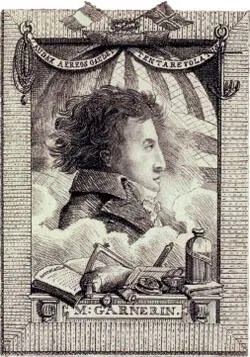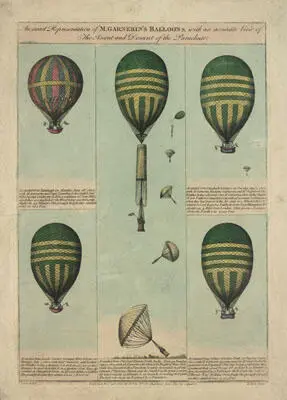1 ...6 7 8 10 11 12 ...23 There was one unforeseen consequence of this. The French balloons quickly came to be universally hated by the opposing allied armies. As a result, they immediately attracted intense and sustained enemy fire, with every weapon that could be mustered, from pistols and muskets to cannon and grapeshot, directed at the observers’ basket. This, concluded Coutelle, made the military aeronaut’s position both peculiarly perilous and peculiarly glamorous.
The Corps d’Aérostiers eventually fielded four balloons, complete with special hangar tents, winches, mobile gas-generating vessels (designed by Lavoisier) and observation equipment. Coutelle would write a racy history of the Meudon balloon school, with modest emphasis on both the tactical and the amorous successes of the French military aeronauts. Wilfrid de Fonvielle later observed: ‘The favour of the ladies followed the balloonists wherever they went, which was not an unmixed blessing, and seems in the end to have contributed to the suppression of the corps.’ 5
With the declaration of war against Britain in 1794, many plays, poems and cartoons imagined an airborne invasion – both French and English – across the Channel. The Anti-Jacobin published invasion-scare cartoons featuring the French guillotine set up in Mayfair, and also extracts from a play purportedly running at the Théâtre des Variétés in Paris: La Descente en Angleterre: Prophétie en deux actes . 6There were some remarkable fantasy drawings of entire French cavalry squadrons mounted on large, circular platforms sustained by enormous Montgolfiers, sailing over the white cliffs of Dover. Nevertheless, the much-feared aerial invasion of England by Napoleon’s army never quite materialised.
In 1797 Napoleon triumphantly took the Corps d’Aérostiers with him to Egypt, counting on the very sight of balloons to put terror into the heart of his Arab enemies, as Hannibal’s elephants had once done in Italy. On 1 August 1798 Coutelle was preparing to unload all his gear outside Alexandria from the French fleet’s mooring at Aboukir Bay when Nelson sailed in at dusk. At the ensuing three-day Battle of the Nile, half of Napoleon’s ships were destroyed, and with them the entire Corps d’Aérostiers. The surviving aeronauts stayed on in Alexandria as technical advisers, like melancholy cavalry officers deprived of their horses. On his return home Napoleon disbanded the corps and the school at Meudon.

Nevertheless, rumours of a French airborne army invading Britain continued to be cultivated, and remained a powerful element in both French and British propaganda long into the nineteenth century. It was the aerial dream turned nightmare.
Civilian balloons and a different kind of competitive showmanship reappeared in France at the time of the Peace of Amiens in 1802. They were promoted by André-Jacques Garnerin (1770–1825), who launched his career by performing a spectacularly dangerous first parachute drop from a balloon over Paris’s Parc Monceau in 1797, when he was twenty-seven. As a young man, Garnerin had fought in the French Revolutionary armies, but he had been captured and incarcerated in the Hungarian castle of Buda for three desperate years. He spent his time there designing imaginary balloons to lift him out of the prison courtyard, or parachutes with which he could leap from the castle battlements. 7Finally released and returned to Paris, he turned his ballooning escape-fantasies into a full-time profession, and became head of the first of the famous French ‘balloon families’ (a role later inherited by the Godards).
Garnerin pioneered a new kind of balloon event: not merely the conventional single ascent, but a whole series of acrobatic displays, parachute drops and night-flights with fireworks. To add to the excitement, his dashing young wife Jeanne-Geneviève made the first recorded parachute jump by a woman in 1799. These shows attracted enormous crowds, and soon the Garnerins became famous throughout European capitals. Garnerin had numerous posters made of their flights, often showing him in heroic, eagle-like profile. Napoleon himself began to see that the balloon had a potential propaganda value even greater than the military one. 8
The Peace of Amiens was barely signed when Garnerin daringly took his balloon show and parachute drops to London. His reception was surprisingly friendly, perhaps because he was joined not only by Jeanne-Geneviève, but also by his pretty niece Lisa. Garnerin’s first London ascent, from Chelsea Gardens on 28 June 1802, attracted a huge audience: ‘Not only were Chelsea Gardens crowded, and the river covered with boats, but even the great road from Buckingham Gate was absolutely impassable, and the carriages formed an unbroken chain from the turnpike to Ranelagh Gate.’ 9

Fearlessly launching in a near-gale, Garnerin flew along the line of the Thames, from the West End to the East End, directly over the City, and then out north-eastwards over the Essex marshes. He was effectively seen by half the population of London. Forty-five minutes later he crash-landed in Colchester, but came back the same day in a coach, gallantly announcing that his balloon had been torn to pieces – ‘we ourselves are all-over bruises’ – but that he would fly again within the week. Indeed, he next ascended from the old Lord’s cricket ground (on the site of the present-day Dorset Square) on 5 July. Advertising his flights with sensational engravings, Garnerin popularised night-ballooning and parachuting in England, and also the dangerous attitude that ‘the balloon show must go on’ whatever the weather.
The following year, 1803, Garnerin published Three Aerial Voyages , describing his London flights and including an amusing account, evidently intended for English readers, supposedly written by his wife’s cat: ‘Brought up under the care of Madame Garnerin, I may be said to have been nursed in the very bosom of aerostation, and to have breathed nothing but the pure air of oxygenated gas since the first moment of my birth. Hearing of my mistress’s intended ascension, I determined to share the danger …’ 10

Scientific ballooning was not entirely forgotten in France. In August 1804 the mathematician Jean-Baptiste Biot and the chemist Joseph Gay-Lussac made a high-altitude scientific ascent, in the one war balloon Coutelle had succeeded in bringing back from Cairo to Paris. They tested the composition of the air in the upper atmosphere, and the strength of the magnetic field, but found no significant alteration from ground level in either. Biot passed out during the descent, so Gay-Lussac went up again alone in September, climbing to 22,912 feet, a new altitude record which would stand for over half a century. Here, in the tradition of Dr Alexander Charles, along with his instrument readings he calmly recorded his breathlessness, fast respiration and pulse, inability to swallow and other symptoms, and concluded that he was very close to the limit of the breathable atmosphere. In the historical section of his classic book Through the Air (1873), the great American aeronaut John Wise later reflected on the courage of these early scientific ascents into the absolute unknown: ‘It is impossible not to admire the intrepid coolness with which they conducted these experiments … with the same composure and precision as if they had been quietly seated in their scientific cabinet in Paris.’ Wise also raised the prophetic possibility of using such high-altitude balloons unmanned for weather observations: ‘Balloons carrying “register” thermometers and barometers might be capable of ascending alone to altitudes between eight and twelve miles.’ But such experiments would have to wait for a time of international scientific cooperation, ‘when nations shall at last become satisfied with cultivating the arts of peace, instead of sanguinary, destructive and fruitless wars’. 11
Читать дальше















